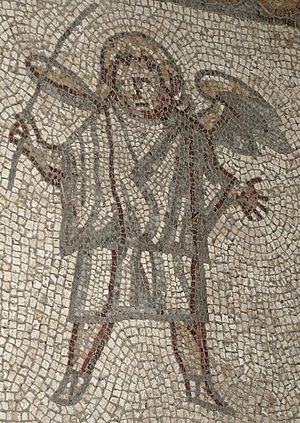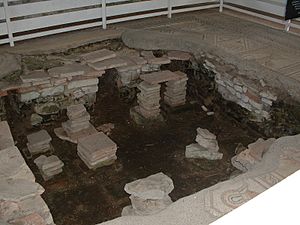Bignor Roman Villa facts for kids
Quick facts for kids Bignor Roman Villa |
|
|---|---|

Bignor Roman Villa, museum buildings
|
|
| General information | |
| Architectural style | Romano-British Villa |
| Location | Bignor, England grid reference SU988147 |
| Country | United Kingdom |
| Coordinates | 50°55′24″N 0°35′41″W / 50.92325°N 0.59475°W |
| Construction started | c. 190 AD |
| Completed | c. 350 AD |
| Closed | c. 400 AD (abandoned) |
Bignor Roman Villa is a huge ancient Roman house in West Sussex, England. It is famous for its beautiful mosaic floors. These floors are like amazing art made from tiny colored stones. They are some of the best and most complete in the whole country! Today, a special charity called the Bignor Roman Villa Charitable Trust takes care of this historical site.
Contents
Where is Bignor Roman Villa?
This ancient villa is found just north of the South Downs hills. It is close to an old Roman road called Stane Street. The villa is about nine miles northeast of Chichester. Chichester was once a Roman city known as Noviomagus Reginorum.
The villa sits on a sunny slope where the soil was good for farming. This helped its owners become very rich from growing crops. Being close to Roman Chichester also made it a great place to live.
A Look Back: The Villa's Story
People lived and farmed here even before the villa was built. Finds show a small farm existed by the end of the 1st century. The first real building was a simple wooden farm structure around 190 AD.
How the Villa Grew
A stone building with four rooms was built in the mid-3rd century AD. Later, between about 240 and 290 AD, more rooms were added. A hypocaust (an underfloor heating system) and a portico (a covered walkway) were also built. This portico faced east towards Stane Street.
This first stone building became the west side of the villa. Around 300 AD, north and south wings were added. In its final form, the villa had about sixty-five rooms. These rooms surrounded a central courtyard. There were also other farm buildings nearby.
The Villa's Final Touches
The last big building work happened between about 300 and 350 AD. This included additions to the north wing. Many of the villa's most beautiful mosaics are found in this part.
We don't know much about what happened to the villa later. It seems to have slowly become less important. It wasn't destroyed suddenly, like the much larger Fishbourne Roman Palace was by fire.
How We Found This Ancient Place
A farmer named George Tupper discovered the villa in 1811. His plough hit a large stone, revealing the ancient site. Most of the villa was then carefully dug up. This work was done by John Hawkins and a historian named Samuel Lysons.
Opening to the Public
The villa opened to visitors in 1814. It quickly became a popular place to see. Almost a thousand people signed the visitors' book in the first nine months! By 1815, a large villa had been uncovered. Special buildings were put up to protect the delicate mosaics.
Samuel Lysons shared his findings about the villa in 1818. He had also published drawings of the villa. These drawings and his notes are important records of the first digs. The excavations stopped in 1819 after Lysons passed away.
Later Discoveries
No more work happened until 1925, when S. E. Winbolt did some small digs. From 1956 to 1962, Sheppard Frere re-examined parts of the villa. He was the first to try and figure out when different parts were built.
Since then, Thomas Tupper, a descendant of the original discoverer, has led more digs. He worked with Margaret Rule in the 1970s and David Rudling in the 1980s. His family still owns the site today.
Amazing Mosaics to See
The rooms you can see today are mostly at the west end of the north wing. These include dining rooms for both summer and winter. The winter dining room even had underfloor heating from the hypocaust! The bathhouse is located to the southeast.
These rooms hold some of the best Roman mosaics in Great Britain. They are well-preserved and show amazing artistic skill. The details in them are truly special.
The northern corridor has a Greek-key pattern. It stretches for about 79 feet (24 meters). This makes it the longest corridor mosaic in all of Britain!




